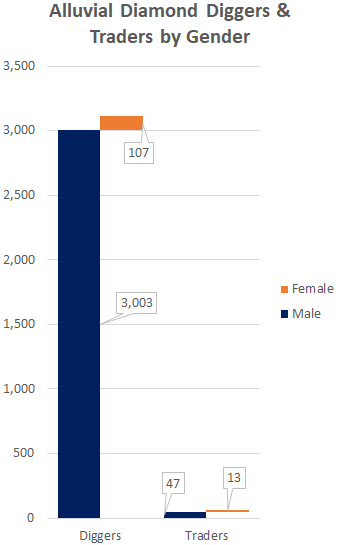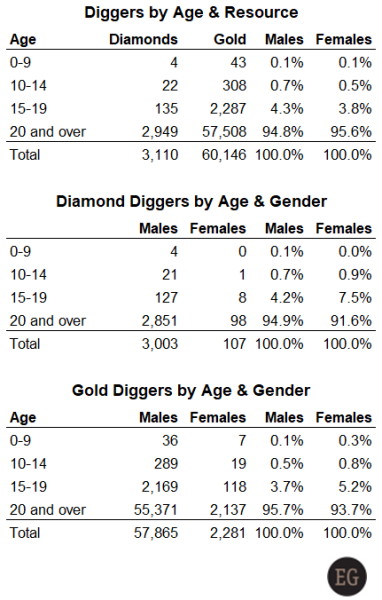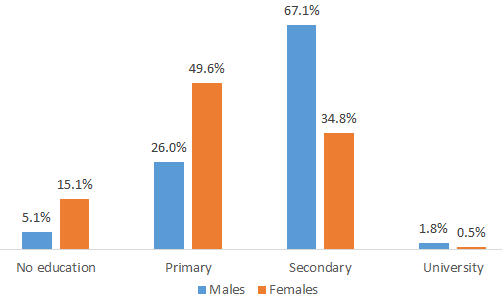Diamonds and gold are mined in some of the most remote areas of the world, some of which are completely off the radar. Few places are as remote as where alluvial mining is taking place in the Democratic Republic of Congo’s (DRC) northeast where women and men, some of who are extremely young, dig for these rare resources for very modest wages.
Tracking retail sales in the US is a “walk in the park” compared to tracking artisanal mining deep in the hot and humid rainforest covered northeast of the DRC. A recent survey of artisanal mining in the Maniema, South Kivu and Orientale provinces of the DRC was a difficult yet rewarding challenge that the Diamond Development Initiative (DDI) took on, and the results are important.
Until recently, we knew little about just who was involved in artisanal mining. And by we, I mean governments, local traders, the diamond industry or anyone else. Some of us had a partial understanding, and a few were aware of who worked at mines they are familiar with, but this was all bits and pieces. No one really had a full picture.
I visited the Kono district in Sierra Leone in 2011 and spoke with artisanal miners and visited mining sites. Some of them shared with me information about what they were doing and where they were from, and showed me their tools, yet this was just a mere glimpse of a far bigger picture, which makes me appreciate the DDI’s undertaking under the remarkable guidance of Dorothee Gizenga even more.
[two_third]This data was collected in 2015 by 48 agents, organized into teams composed of government, civil society and private sector representatives, who traveled 12,000 kilometers by motorcycle and, incredibly, another 3,000 kilometers by foot to reach the most remote artisanal mining sites. Underscoring this achievement, more than half of the mining sites (57%) were previously unknown. The main goal of this project was to register artisanal miners and enable government oversight and better governance of the sector. The data that was collected – age, gender, education level and location – reveals much about this group.[/two_third][one_third_last]
“Underscoring this achievement, more than half of the mining sites (57%) were previously unknown.”
[/one_third_last]
The project covered a huge land mass of some 700,000 square kilometers in DRC’s northeast, with an estimated population of 16 million people having a population density of just 22.8 per square kilometer. By comparison, France (without its overseas territories) is 551,500 square kilometers in size, with a population of more than 65 million and a population density of 118 per square kilometer.
Artisanal mining findings
In total, the DDI registered 108,169 artisanal workers who mine a variety of metals and minerals, among them gold and diamonds, but also tin, tantalum and tungsten. The overwhelming majority of these people – 93,364 or 86.3% – worked at gold mining locations. These include sites where gold is mined, as well as where diamonds are also mined, or where gold and cassiterite (tin) are mined.

Compared to gold, which commands the largest workforce, only a small number of people worked at diamond mining sites: 6,776. Of them, 1,600 worked at pure diamond mining sites (1.5%), and another 5,176 (4.8%) worked at sites that had both gold and diamonds, 6.3% of the total.
Compared to gold, which commands the largest workforce, only a small number of people worked at diamond mining sites: 6,776. Of them, 1,600 worked at pure diamond mining sites (1.5%), and another 5,176 (4.8%) worked at sites that had both gold and diamonds, 6.3% of the total.
Please note that in the following figures, when discussing diamonds or gold, there may be a certain overlap because of places where both gold and diamonds are mined.
Gender: While mining is traditionally a male-dominated job, both men and women work at these sites. Of those working in diamonds, 59% are men, a small tilt. However, artisanal gold mining sites are very male oriented – 70.7%.
Not all those working at artisanal mining sites are diggers – workers who do the actual extraction work. Some are traders, whereas others perform services such as food vending and first-aid provision.
The number of diamond diggers was 3,110, or just 46% of those working at diamond sites. Not surprising, 97% of them were male, and only 107 – 3% of diamond diggers – were female.
Age: According to Western sensibilities, this is completely unacceptable. Girls of this age should be playing, not working – especially not performing physically difficult manual labor. In addition to these young girls, two 6-year-old boys were found working at a gold mine.

In total, there were 26 diggers aged 14 or younger working at diamond mines, and 351 at gold mines. The average age of diamond diggers is 32.
Another surprising finding was the number of teenage girls working as gold traders at these mining sites. There were ten female traders aged 19 or younger. Four of them were 19 years old, one was 14 years old and two gold traders were just 11 years old. There were no teenaged female diamond traders.
Among boys, there were three 11-year-old gold traders, a 10-year-old boy and a 9- year-old gold trader. Again, no children were involved in diamond trading.
In total, there were 13 female diamond traders and 181 gold traders. If it weren’t for the large percentage of children included in these figures, this news might have been encouraging.
Education: More than two thirds of diggers (66.9%) had a high school education or better. There were even several university-educated diggers at these mines – 1,190 people. Almost all of these university-educated diggers, 1,168, were men and 22 were women.
Another disturbing discovery is the gender ratio breakdown in education. While 67% of the men working in alluvial mining had a high school education, only 35% of the women did. While 0.5% of female diggers had a university education, a staggering 15% reported no education at all. Among males, 1.8% had a university education, and only 5% had no education.

We bear a responsibility
[two_third]
Currently, the diamond and jewelry industries are in the midst of deep change in regard to traceability. Traceability commonly refers to the processing stages along the value chain. The goal is to ensure that the value chain operates legally and adheres to a high moral standard, and transparency is the method of ensuring that this happens. However, high moral standards cannot exist without ensuring the well-being of the people involved in the process, and this starts with the weakest, most remote and, therefore, the most vulnerable people – the labor force working at mines deep in the rainforests of Africa.
As people who make a living from diamonds, gold and jewelry, we rely on the work of alluvial mine workers and, consequently, it is our responsibility to make sure their working conditions are adequate, their pay is reasonable, and their health is protected.
[/two_third][one_third_last]
“However, high moral standards cannot exist without ensuring the well-being of the people involved in the process, and this starts with the weakest, most remote and, therefore, the most vulnerable people – the labor force working at mines deep in the rainforests of Africa.”
[/one_third_last]
